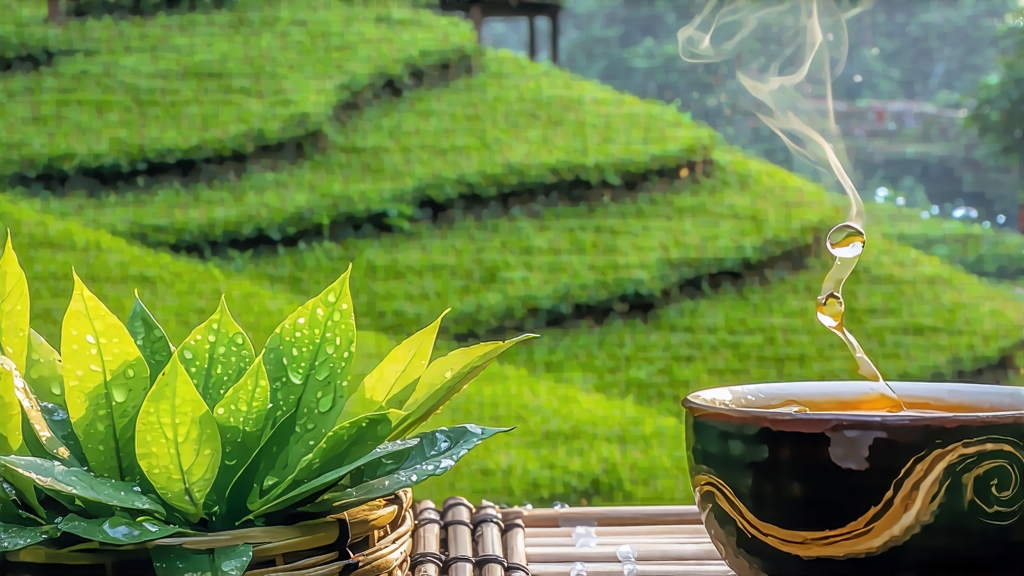
Rising like a jade dragon from the Tropic of Cancer, Taiwan’s Alishan massif is revered less for its 2,663-metre summit than for the diaphanous clouds that drape its shoulders 1,000–1,400 metres lower. In that cool, perpetual mist grows one of the most coveted oolongs on earth: Alishan High-Mountain Oolong, a tea whose very name evokes altitude, purity and a silken cup that tastes of orchid, lilac and fresh cream.
To international drinkers familiar only with dark roasted Wuyi rock teas or the greenish Tie Guan Yin of Fujian, Alishan can feel like a revelation—lighter, brighter, yet still unmistakably oolong. Its story begins in the late nineteenth century when Qing-dynasty settlers from Fujian carried Qing Xin (Green Heart) cultivar cuttings across the strait. The plants, accustomed to the mineral cliffs of Anxi, awoke in Alishan’s acidic, iron-rich laterite soils and a climate where daytime sunshine is filtered through fog and nighttime temperatures can plunge ten degrees. The stress slowed leaf growth, concentrating amino acids and volatiles, and the mountain’s constant mist acted as a natural insect repellent, allowing farmers to garden with minimal agro-chemicals long before “organic” became a market buzzword.
Yet terroir alone does not explain Alishan’s charm; craft completes it. The harvest season unfolds five times a year, yet spring (April) and winter (October) flushes are judged supreme. On the eve of picking, growers watch mercury and moisture like vintners: clear afternoons followed by cool nights promise the highest aromatic potential. At dawn, teams of pluckers—often entire families—move in silent choreography, snapping only the apical triad: one tender bud flanked by two semi-mature leaves. Within minutes the baskets are rushed to the on-mountain factory, for in oolong chemistry the clock is merciless.
Withering begins outdoors on vast bamboo trays set under shade cloth. Here the leaves lose roughly 10 % moisture while enzymes start converting grassy aldehydes into floral alcohols. Every fifteen minutes the tea master tosses the leaves skyward, letting them slap back against the tray; this gentle bruising ruptures cell walls just enough to invite oxidation without the full assault seen in black tea. After ninety minutes the leaf edges redden, signalling “light fermentation,” the hallmark of modern Taiwanese high-mountain style.
Indoors, the leaf enters the rocking phase—an Alishan signature. Inside a cylindrical bamboo drum the leaves are tumbled for three-minute bursts, rested, then tumbled again for up to an hour. The repeated friction twists the leaf edges, coaxing a slow, even oxidation that hovers around 25 %, far less than the 50–60 % of traditional mainland oolongs. When the master detects the precise bouquet—imagine walking through a wet orchid greenhouse—oxidation is halted with a high-temperature “kill-green” bake at 260 °C for ninety seconds.
What follows is the most visually recognisable step: ball-rolling. The still-warm leaves are wrapped in a square of white cloth, cinched into a tight sphere, and placed inside a hydraulic drum that rotates and compresses for three minutes. The bundle is opened, the leaves fluffed, then re-wrapped and rolled again—up to thirty cycles over two hours. This labour-intensive ritual not only shapes the glossy, dark-green pearls sold the world over but also squeezes residual moisture from the stem, ensuring a clean, crisp cup. A final low-temperature roast (80–90 °C) for 4–6 hours sets the moisture at 3 % and layers in a subtle cream note that connoisseurs liken to Taiwanese nougat.
To unlock Alishan’s mountain soul, water is everything. Use freshly drawn, low-mineral spring water brought to 95 °C—just off a rolling boil. Pre-warm a 120 ml porcelain gaiwan or a pear-shaped clay teapot; unglazed Yixing pots are acceptable but must be dedicated to light oolongs only, lest roasted memories intrude. Measure 6 g of leaf (roughly two heaping tablespoons) and rinse for five seconds, discarding the liquor. This “awakening” rinse unfurls the pearls and rinses away any microscopic mountain dust.
The first formal infusion lasts fifty seconds. Pour in a high